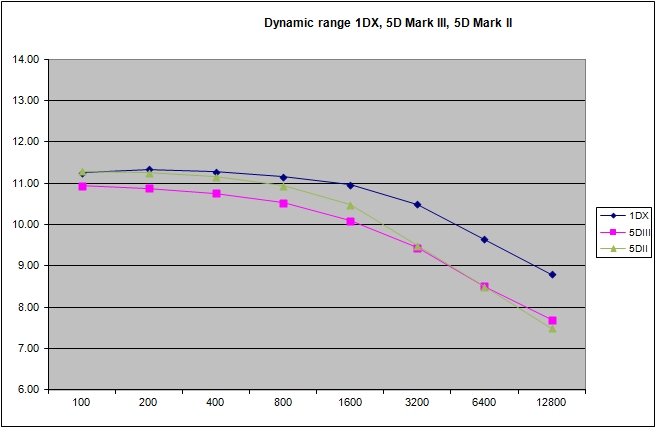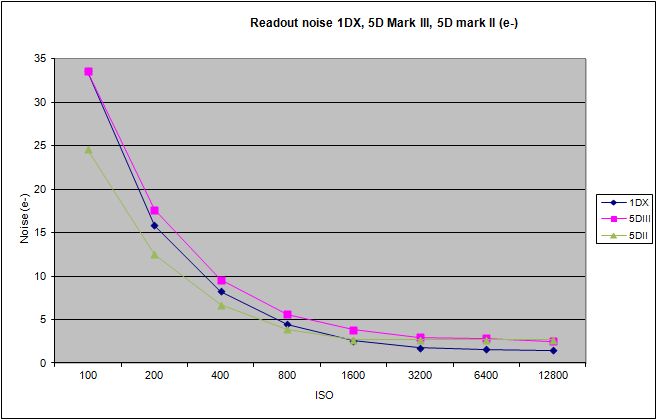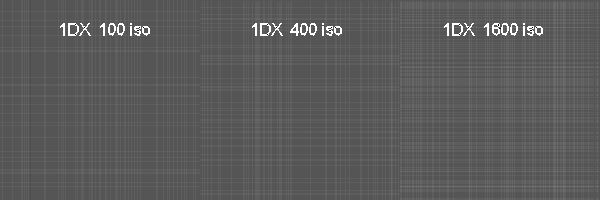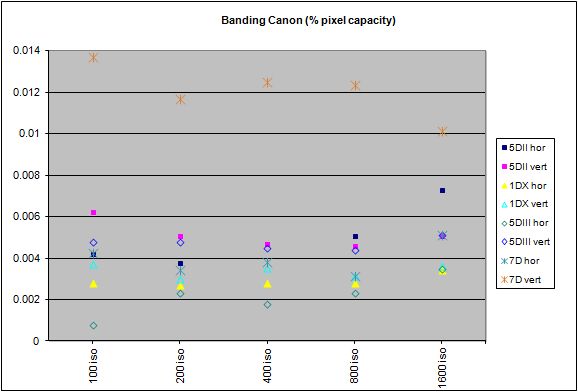
CANON 1DX: Dynamic range and banding measurements
Here is the dynamic range chart for the new Canon 1DX, compared to the 5D mark II and mark III.

The dynamic range is defined as the ratio between the pixel capacity and the readout noise. This definition being similar to the one used by DxO Labs, the chart above is comparable to the DxO Labs dynamic range chart in "screen" mode. Pixel capacity are respectively 81000, 66000 and 61000 electrons at 100 iso for the 1DX 5DIII and 5DII (the usable pixel capacity decreases in proportion with the iso setting). The readout noise is represented in the following chart:

The 1DX offers a better dynamic range, thanks to a higher pixel capacity and a lower readout noise (at least over 1600 iso: surprisingly, the readout noise of the 1DX, as well as the 5D mark III, is higher at low iso than the readout noise of the 3 years old 5DII!). 1DX dynamic range is a bit better at 200 iso than at 100 iso, and similar at 100 iso and 400 iso. However, banding plays an important role in the actual usable dynamic range and the performance of a Canon SDLR cannot be assessed without considering it (see below).
Banding is a woof of random vertical and horizontal lines superimposed to the background of the image. Although its average amplitude is much lower than the readout noise (typically 5 to 10 times), it is sometimes visible in the shadows of a photograph because human vision is extremely effective in detecting lines. Thanks to a special processing able to extract banding from readout noise and to measure its amplitude, here a small 100% crop of 1DX offset images at 100, 400 and 1600 iso:

As on older Canon DSLR, the banding level of the 1DX does not change much with the iso setting, as demonstrated in the following chart showing the horizontal and vertical banding average level for the 1DX, 5DIII, 5DII and 7D. For each camera the banding level is scaled to the pixel capacity, to make the figures comparable between images showing the same scene with similar histogram profile. The banding levels of the 1DX and the 5DIII are comparable and are significantly lower than for the 5DII.

Below are crops taken at 400 iso for the same list of cameras. Banding is essentially vertical on the 7D and 5DIII, while the former suffers from a lower pixel capacity due to its smaller pixels.

Note: unfortunately, the dynamic range and banding level of Nikon cameras are very difficult to measure, because the offset level (the background level of a very short exposure in the dark) is set to zero before recording the file on the memory card, leading to the loss of the small negative noise and banding fluctuations. However, Nikon cameras do not seem to show banding. I have analyzed Pentax K5 images and they show no measurable banding.